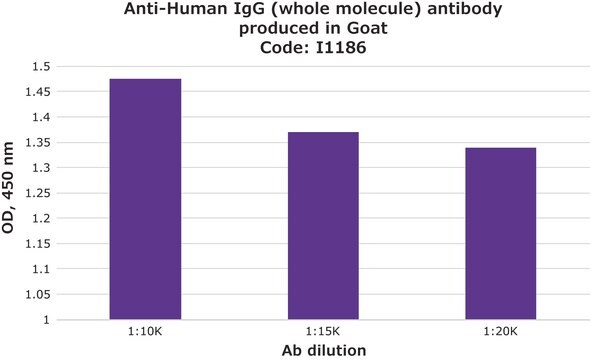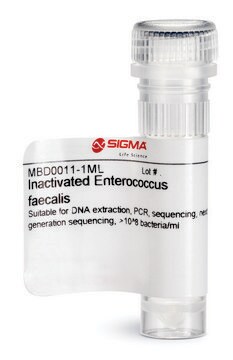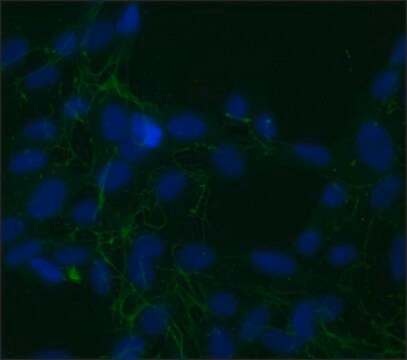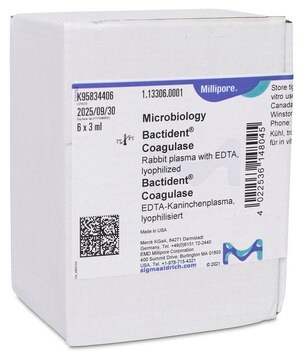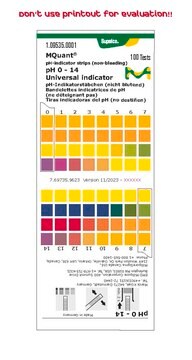SAB4200883
Anti-Staphylococcus aureus LTA antibody, Mouse monoclonal
clone LT-43, purified from hybridoma cell culture
Sinónimos:
Staphylococcus aureus
Iniciar sesiónpara Ver la Fijación de precios por contrato y de la organización
About This Item
UNSPSC Code:
12352203
NACRES:
NA.41
Productos recomendados
antibody form
purified from hybridoma cell culture
Quality Level
clone
LT-43
form
liquid
species reactivity
Staphylococcus aureus
concentration
~1 mg/mL
isotype
IgM
shipped in
dry ice
storage temp.
−20°C
target post-translational modification
unmodified
General description
Staphylococcus aureus is a Gram-positive bacterium, that causes disease in the human population including food poisoning and toxic shock syndrome.1 S. aureus expresses several secreted virulence factors, such as various enzymes, cytotoxins, exotoxins, and exfoliative toxins.1 Exotoxins include more than 20 serologically classified staphylococcal enterotoxins (SEs). The best characterized are the SEs A, B through V, and toxic shock syndrome toxin-1 (TSST-1). These enterotoxins are similar in activity, sequence, structure, and molecular mass (25-30 kDa).1-3
Specificity
Monoclonal Anti- Staphylococcus aureus lipoteichoic acid (LTA) antibody specifically recognizes LTA of Staphylococcus aureus and has no cross reactivity with Bacillus subtilis LTA and Enterococcus hirae LTA.
Application
The antibody may be used in various immunochemical techniques including Immunoblotting and ELISA.
Biochem/physiol Actions
SEA and SEB are known as superantigens due to their ability to bind class II MHC molecules on antigen presenting cells. This binding stimulates extensive T-cell activation followed by massive cytokine release leading to an acute toxic shock.1-4 SEB is also classified as a category B select agent and is important toxicant in biodefense research.5-9SE proteins have a significant resistance to heat and acid, and are also resistant to gastrointestinal proteases including pepsin, trypsin, rennin, and papain. Thus, inactivating the S. aureus bacteria may not be sufficient to eliminate the risk of its superantigens from causing food poisoning.1 SEB contamination can be caused by both its ingestion (resulting with food poisoning) or by inhalation (resulting with respiratory symptoms of cough and dyspnea), therefore SEB detection is a major challenge in the food industry.1,3,5-10
Physical form
Supplied as a solution in 0.01 M phosphate buffered saline pH 7.4, containing 15 mM sodium azide as a preservative.
Storage and Stability
For continuous use, store at 2-8°C for up to one month. For extended storage, freeze in working aliquots. Repeated freezing and thawing is not recommended. If slight turbidity occurs upon prolonged storage, clarify the solution by centrifugation before use. Working dilution samples should be discarded if not used within 12 hours. Protect from prolonged exposure to light.
Disclaimer
This product is for R&D use only, not for drug, household, or other uses. Please consult the Material Safety Data Sheet for information regarding hazards and safe handling practices.
Storage Class
12 - Non Combustible Liquids
wgk_germany
WGK 1
Certificados de análisis (COA)
Busque Certificados de análisis (COA) introduciendo el número de lote del producto. Los números de lote se encuentran en la etiqueta del producto después de las palabras «Lot» o «Batch»
¿Ya tiene este producto?
Encuentre la documentación para los productos que ha comprado recientemente en la Biblioteca de documentos.
Nuestro equipo de científicos tiene experiencia en todas las áreas de investigación: Ciencias de la vida, Ciencia de los materiales, Síntesis química, Cromatografía, Analítica y muchas otras.
Póngase en contacto con el Servicio técnico

